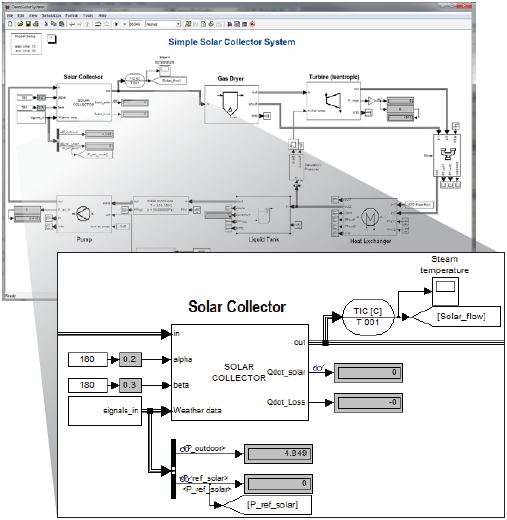Third-Party Products: Model-Based Design for Renewable Energy Systems
Third-party solutions enhance Model-Based Design for system engineering and embedded-system development in renewable energy applications. Libraries of specialized components enable engineers to model and simulate solar and fuel cell systems, conduct trade studies, and specify system architectures. Embedded targets let them generate code from Simulink® models for the PLC systems and microcontrollers used to control wind turbines, solar power inverters, and hydrogen fuel cell systems.
Autonomie is a development environment for powertrain and vehicle modeling that supports the rapid evaluation of new technologies for improving fuel economy. It includes Simulink and Stateflow® models of electric, hybrid electric, plug-in hybrid, fuel cell, and other advanced powertrains. Autonomie models provide multiple levels of fidelity and abstraction, enabling the simulation of subsystems, systems, or entire vehicles.
Thermolib provides a set of Simulink blocks for modeling and simulating thermodynamic and thermochemical systems, including traditional and solar power plants, fuel cell vehicles, and HVAC systems. These building blocks enable engineers to create user-defined components or systems and simulate them within Simulink. Thermolib provides demos for common combustion processes, heat pumps and refrigeration cycles, fuel cells, gas turbines, and battery thermal management systems.
Texas Instruments C2000™ MCU family includes integrated peripherals appropriate for solar power inverter control applications. Typical inverter control algorithms are based on reading solar module voltages through on-chip ADCs and controlling AC power output through high-resolution PWM outputs. TI offers Renewable Energy Developer’s Kits containing C2000-based DC/AC inverters, as well as integrated development tools, including Code Composer Studio™ (CCS). Engineers can generate C and C++ code directly from their algorithms in Simulink and compile it with CCS using target I/O blocks for C2000 peripherals provided with Embedded Coder™.
Integrated into Bachmann’s M1 automation systems, M-Target for Simulink provides blocksets of M1 I/O cards, as well as variable and parameter interchange blocks for developing advanced controls for wind turbine systems. Designed as a target for Simulink Coder™, it lets engineers automatically generate code and deploy their Simulink models directly to M1 controllers in hardware-in-the-loop systems or actual plants.
Published 2012 - 92049v00


